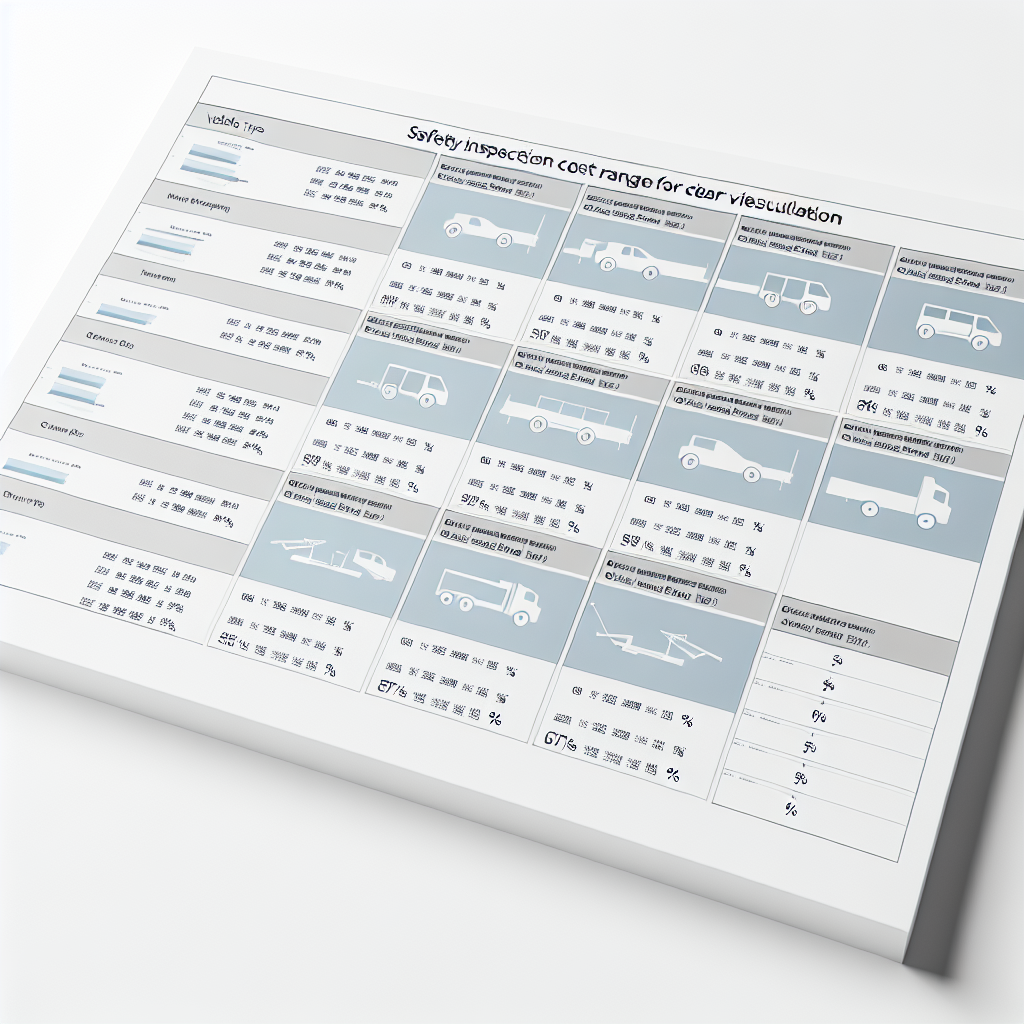Safety Inspection Fraud in Ontario’s Trucking Industry
Safety inspection fraud in Ontario’s trucking industry has become a major concern that threatens public safety and the integrity of regulations. Recent reports by Truck News reveal shocking claims of vehicles operating on the roads with falsely obtained safety inspection decals. In a thorough examination, shop owners and industry experts highlight a troubling pattern of unsafe heavy-duty vehicles being given inspection stickers without any real inspections taking place. This manipulation of safety protocols not only exploits regulatory loopholes but also raises serious questions about the current oversight mechanisms intended to ensure trucks are safe before they hit the highways.
The findings show a concerning trend of negligence and complicity that could have serious consequences for public safety. Statistics indicate high rates of non-compliance during enforcement efforts—one study found that 50% of inspected vehicles were put out of service due to major violations. This suggests that the effects of unethical safety practices go far beyond individual cases. The systemic failures identified in these investigations highlight the urgent need for stricter enforcement of safety regulations and greater accountability in the inspection process. Only through strong regulatory reforms can we hope to eliminate safety inspection fraud and ensure the safety of all road users in Ontario.
Importance of Ethics in Safety Inspections
The importance of ethical practices in safety inspections is a critical area that needs attention, especially in the context of the trucking industry safety. A key example is the situation in Ontario where unethical practices have allowed uninspected and unsafe vehicles to operate on the roads, directly endangering public safety. Investigative reports from outlets like Truck News reveal significant failures in safety inspections, where inspection stickers are being fraudulently obtained, often at the expense of thorough inspections of vehicles. This lack of compliance not only undermines safety but puts lives at risk.
- Ethical Integrity: Ensuring compliance with regulations is more than a matter of legal obligation; it is a fundamental aspect of maintaining public trust in safety systems. When unethical behavior is allowed to fester, it raises the frequency of accidents and incidents that could have otherwise been avoided, diminishing overall vehicle compliance.
- Financial Implications: The financial implications of failing to enforce ethical standards during vehicle inspections are significant, leading to increased insurance claims, potential legal liabilities, and damage to a company’s reputation. Regulatory bodies must remain vigilant in their oversight, utilizing measures such as audits, transparency initiatives, and clearer reporting requirements on inspection histories.
- Consequences of Negligence: In Ontario, the consequences of failing to enforce ethical practices are vividly illustrated by statistics indicating high out-of-service rates during vehicle checks. An apparent disregard for ethical standards in vehicle safety scrutiny ultimately threatens lives, creates financial burdens, and undermines the legitimacy of regulatory frameworks. Therefore, prioritizing ethical practices is not merely an option; it is an ethical obligation that all stakeholders involved in safety inspections must bear. Upholding ethical standards will not only enhance public trust but also ensure a safer and more compliant trucking industry.
Key Facts
Understanding the financial implications and safety statistics concerning commercial vehicle inspections is vital in assessing the issues surrounding safety inspection fraud in Ontario. Here are some key facts:
- Cost of Annual Safety Inspections: The typical cost for annual safety inspections is approximately $800 to $1,000 for a tractor and $500 to $650 for a trailer. This significant expenditure highlights the financial importance of maintaining proper safety checks on vehicles.
- FMCSA Vehicle Out-of-Service Rate: The Federal Motor Carrier Safety Administration (FMCSA) reports an alarming national out-of-service (OOS) rate of 28%, notably above the national average of 22%. During the 2025 International Roadcheck, 18.1% of vehicles inspected were placed out of service due to serious violations. In the previous year, the OOS rate was recorded at 23%. Such statistics emphasize the prevalence of maintenance issues across the sector, indicating that many vehicles may be unfit for safe operation.
- Consequences of Non-Compliance: These out-of-service violations not only pose risks to public safety but also incur hefty financial penalties. Fines from the FMCSA for maintenance violations can reach $19,246 for general maintenance failures to as much as $23,647 for allowing the operation of a vehicle that has been classified as out of service. The financial ramifications clearly stress the need for diligent adherence to vehicle safety regulations.
By focusing on the financial implications and alarming OOS statistics, we can better understand the necessity for stringent safety inspections and the potential dangers posed by unethical practices in the industry.
The situation involving ATG Repair has raised serious allegations concerning fraudulent safety inspection practices. Footage has surfaced showing an individual at ATG Repair affixing U.S.-issued inspection stickers to Canadian vehicles without conducting the requisite inspections, undermining the validity of safety protocols.
This unethical behavior has been corroborated by video evidence submitted by a concerned Toronto-area heavy-duty repair shop owner, who claimed that authorities, specifically the Ontario Ministry of Transportation, have largely failed to address these allegations. Further compounding the issue, vehicles displaying ATG Repair decals lack inspection histories within the DriveON portal, casting doubt on the legitimacy of these inspections.
An alarming incident was documented where a trailer, presenting an ATG inspection sticker dated May 2025, was later discovered in New York with severe mechanical defects, including compromised tire conditions and structural damages. This situation not only questions the credibility of ATG Repair’s inspection process but also highlights the potential hazards posed by vehicles operating without the necessary safety validations, calling for urgent scrutiny and regulatory action.
Individuals affected by the ongoing safety inspection fraud issues in Ontario have conveyed profound frustrations with the current inspection processes. James Menzies’ sentiment mirrors that of other industry professionals, who describe a system plagued by inadequate enforcement and ineffective oversight from regulatory authorities.
One notable voice, Steve Shipton, a licensed inspection shop owner, pointed out ongoing fraudulent activities within the inspection system. He recounted the almost absurd efficacy of the fraud; a truck that had received a passing DriveON sticker was subsequently brought to his facility, revealing approximately $30,000 worth of repairs needed, including critical brake and kingpin defects. This stark reality highlights the dangers of unsafe vehicles being cleared through fraudulent inspections. Shipton emphasized the significance of these oversights, stating that allowing such vehicles on the road poses severe risks to public safety.
Moreover, frustrations extend beyond individual cases to systemic issues, with mentions of violations related to the DriveON program’s protocols. Shipton noted that despite reporting these violations to the Ministry of Transportation (MTO), there has been a disappointing lack of accountability and enforcement. The industry professionals are thus pinning their hopes on the DriveON initiative as a catalyst for change, believing that its implementation will help eradicate fraud and reinforce vehicle safety standards throughout Ontario’s trucking industry. This reveals a collective hope that DriveON’s introduction will foster a more transparent and reliable inspection process, ultimately ensuring safer roads for all.
In conclusion, the persistent issues surrounding safety inspection fraud in Ontario’s trucking industry are not just regulatory oversights; they are a profound threat to public safety and ethical standards. The heart-wrenching reality is that uninspected vehicles continue to roam freely on our roads, endangering lives and eroding public trust in vital safety systems. The emotional weight of accidents caused by negligent practices is felt not only by victims and their families but also by a community that relies on the integrity of transportation that supports its economy.
Swift action from regulatory bodies is necessary to address these glaring failures. There needs to be an overhaul in oversight mechanisms to ensure that safety inspections are conducted ethically and that the maintenance of vehicles is taken seriously. Every stakeholder in the trucking industry must recognize their responsibility not just to comply with regulations but to uphold the trust and safety of the public.
Without immediate and robust regulatory scrutiny, the ongoing normalization of fraudulent safety practices will only worsen, leading to catastrophic consequences. Thus, it is imperative that we advocate for reforms that emphasize accountability, transparency, and vigilant enforcement in the inspection processes across Ontario.
| Vehicle Type | Safety Inspection Cost Range | Out-of-Service Rate (%) |
|---|---|---|
| Tractors | $800 – $1,000 | 28% |
| Trailers | $500 – $650 | 18.1% |

The image displays a comparison table showing safety inspection costs and out-of-service rates for different types of commercial vehicles.

An image representing the ethical dilemma of safety inspection fraud in truck inspections, showcasing trucks with inspection stickers and distressed professionals.
Regulatory Compliance Risks Associated with Fraudulent Safety Inspection Practices
- Legal Ramifications: Engagement in fraudulent practices can lead to severe penalties under law, including criminal charges for fraud, harmful liability for owners, and revocation of business licenses.
- Financial Implications: Companies caught in fraudulent activities may face hefty fines, a rise in insurance premiums, and the potential for costly lawsuits stemming from accidents involving uninspected vehicles, leading to bankruptcy.
- Safety Risks: Vehicles operating with fraudulent inspection stickers may not meet safety requirements, significantly increasing the risk of accidents, injuries, and fatalities on the road which impacts drivers and the general public.
- Damage to Reputation: Organizations found guilty of fraudulent safety inspections can suffer long-term damage to their brand reputation, leading to a loss of customers, partnerships, and market share.
- Increased Regulatory Scrutiny: Repeated incidents of fraud will likely prompt stricter regulations and oversight from government agencies, complicating operations for legitimate businesses trying to comply with laws.
User testimonies and public comments reveal significant concerns regarding the effectiveness and reliability of Ontario’s safety inspection process, particularly from industry professionals, truck owners, and the general public. Key points include:
-
Erosion of Safety and Compliance Standards: Stakeholders, including the Ontario Safety League and the Ontario Trucking Association, have expressed alarm over the decline in safety and compliance standards within the trucking industry. They highlight the rise of carriers operating with widespread non-compliance, lacking commitment to vehicle and driver safety, and disregarding labor standards. One stakeholder emphasized, “It feels like watching a slow-motion disaster unfold as more unsafe vehicles take to the roads, all because of fraud in the inspection process.”
[Truck News] -
Ineffective Enforcement and Inspection Practices: Critics argue that the Ministry of Transportation of Ontario’s (MTO) inspection blitzes are more symbolic than impactful. Despite conducting over 48,000 inspections under Operation Deterrence, only 6.2% resulted in vehicles being placed out of service, suggesting that inspections may not be effectively targeting the most hazardous carriers. As one inspection shop owner remarked, “I have lost count of how many times I’ve seen vehicles pass inspections that shouldn’t be on the road at all.”
[US DOT] -
Auditor General’s Criticisms: The Auditor General of Ontario has repeatedly criticized the MTO for inadequate enforcement efforts, citing issues such as insufficient enforcement officers, a decline in roadside inspections, inconsistent enforcement across districts, and lax oversight of carrier self-testing of drivers. A report from the Auditor General noted, “Each day, it feels as if I’m watching countless unsafe vehicles drive by, leaving me feeling powerless.”
[Truck News] -
Fraudulent Safety Certifications: Investigations have uncovered instances where unsafe vehicles were operating with fraudulently obtained safety inspection decals. This practice undermines the integrity of the inspection process and poses significant safety risks to the public. One driver interviewed shared, “It’s terrifying to think that the truck next to me on the highway could be a ticking time bomb due to a fraudulent inspection.”
[Truck News]
These points underscore a widespread perception among industry professionals and the public that Ontario’s safety inspection process may not be effectively ensuring road safety, necessitating urgent reforms and stricter enforcement measures.
